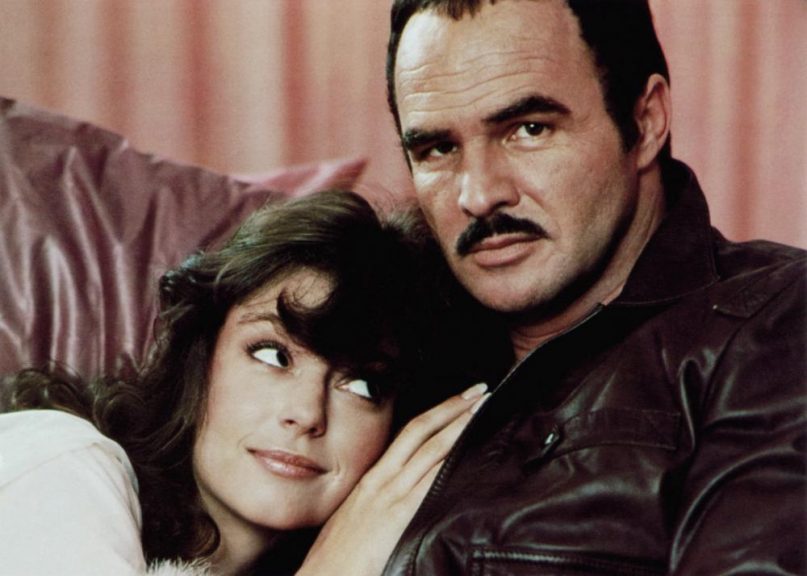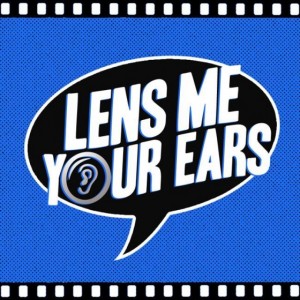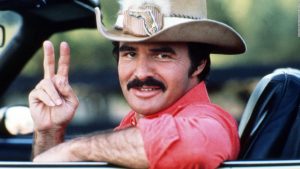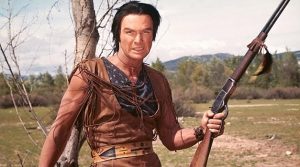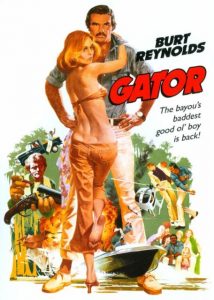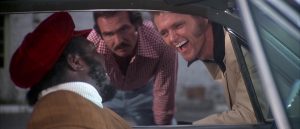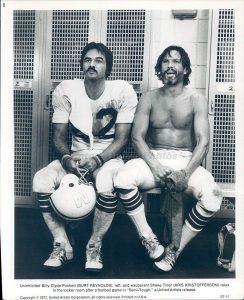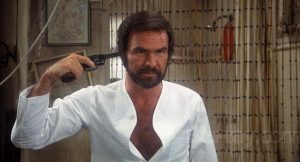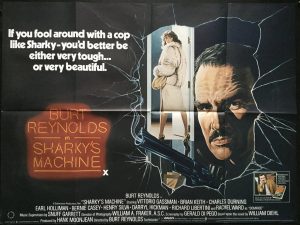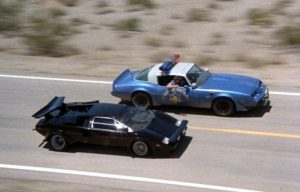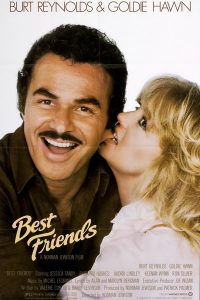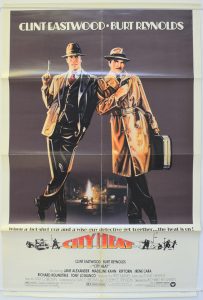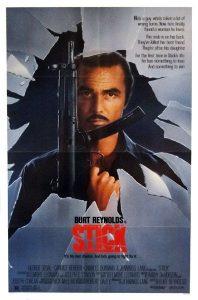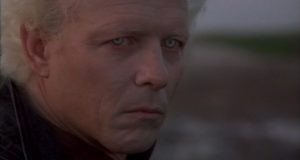This week’s episode of the podcast I do with Stephen Cooke, LENS ME YOUR EARS, is about Burt Reynolds, who died recently. Stephen and I are of the generation where Reynolds was one of the first movie stars either of us got to know, whose work left a big impact on our childhood moviegoing. Stephen and I speak about the films we remember and rewatch a bunch, too.
Please visit Stitcher or Apple Podcasts to download the episode and if you like what you hear, please leave us a positive review and rate the show.
I’d also like to include my notes for the episode here in this post. We went on a few tangents—and Stephen talked about some of Reynolds’ films that he watched and I had not—so if you listen you’ll hear a lot that isn’t included here, but for those who’d rather read than listen, here are my capsule reviews of the some of Burt’s filmography:
In the 1970s he was the most popular movie star of his generation. My father enjoyed his movies almost as much as Clint Eastwood, and passed that affection on to me. I don’t think Burt’s movies have aged quite as well as Clint’s, mind you—he made a lot of mediocre pictures, but he had an ability to effortlessly carry a film on his charm, and that’s nothing to sniff at.
Reynolds was a comedic lead, capably physical for the requirements of 1970s action cinema—but he also had dramatic chops. He was notorious for making bad decisions with his career… he turned down Garrett Breedlove, the role in Terms of Endearment that earned Jack Nicholson his second Academy Award. And he turned down the Richard Gere part in Pretty Woman. Can you imagine him in that? It would’ve been a very different film.
He was a real movie star, and he was the first guy I ever saw who winked right at the camera, broke the fourth wall to make the audience a co-conspirator in his fun.
Navajo Joe (1966)
Reynolds is reported to have said of this Spaghetti Western, “It’s so awful it was only shown in prisons and aeroplanes because nobody could leave.” If considering this film at all, be aware that Reynolds plays a Native American in a film made by Italians. The racial optics of pictures like this are hard to stomach.
We don’t see much of the hero at first… he’s a renegade “Indian” who wants to bring down a bunch of cowboy bandits who’ve killed his wife, but we spend most of our time with the bad guys and townspeople. When Joe does show up, he doesn’t say too much. There’s a really terrible score, with a lot of chanting the name “Navajo Joe” in what some white people think Native American music is like. Apparently, it was scored by Ennio Morricone under a pseudonym, presumably to hide his shame.
And most of the townsfolk are either cowards or conniving with Reynolds the toughest badass around helping people despite themselves, the Eastwood model for so many of his westerns. You can see Reynolds does most of his stunts, which is something, and there’s some decent action-related camerawork, but the movie is for Burt completists only.
Deliverance (1972)
Reynolds did a lot of TV and unremarkable movies in the 1960s, but got his critical break in John Boorman’s Deliverance, with Jon Voight, Ned Beatty, and Ronny Cox. It’s an ensemble, and Reynolds wasn’t the lead, but he was the actor with the most charisma in the group, the alpha male. He gets grievously injured, allowing for Voight’s character to step up. Still very much a classic.
Gator (1976)
Reynolds’ first film as a director, a sequel to White Lightning from 1973. I wasn’t much of a fan of the original, but I enjoyed this one more. It still has a lot of problems, mind you, mostly in its management of tone.
At first this looks like it’ll be a good-il-boy romp, previewing the success of Smokey and the Bandit. Gator McCluskey (one of the great character names ever) is a two-time loser, just back from jail. His nine-year-old daughter and senior-citizen father live in the swamp when the justice department comes calling in the person of New Yorker Irving Greenfield (played by Jack Weston).
Though this all starts with a great speedboat chase through the swamp, that fun and games doesn’t last. Greenfield wants Gator to get back together with his old pal Bama McCall (Jerry Reed, convincingly evil), a gangster who runs a local town. They figure Gator will do anything to go back to prison, including being a snitch on Bama. To seal the deal, Greenfield absconds with Gator’s daughter and father, who we never see again for the rest of the movie. Gator mentions the girl in passing, but they just vanish.
When Gator starts hanging out with Bama, it becomes a morality tale: Gator doesn’t like what he sees Bama doing, including extortion of poor people, arson, and running a bordello with drug-addicted, 15-year-old prostitutes. Gator isn’t conflicted because he’s working for the man, he’s conflicted because his old buddy Bama is a much worse guy than Gator is. Gator wants out, and Bama drugs him, giving Burt the best scene in the movie, when he gets giddy and starts insulting Bones, Bama’s enormous bodyguard played by William Engesser. Bones is so tall, his head sticks out of the sunroof of the Lincoln he drives Bama around in. So there’s that kind of silliness, in the midst of the drama and occasional grit.
Then, later, when Lauren Hutton shows up as a crusading newsperson, it becomes a bit of a romance, but kind of a tragic one at that. This is three different movies in one, and none of them really make much sense mixing together. The pleasure here largely comes from Reynolds just cruising through the film, confident in his star appeal.
Smokey And the Bandit (1977)
Directed by former stunt person Hal Needham, this is Reynolds’ signature role in his most popular movie. Watching it again I realized how much of this is just riding on his charisma. There’s next to no plot or stakes, it’s just Bandit driving his car at high speed running interference to allow this truck full of beer to get from Texarkana to Georgia. It made me wonder, doesn’t Georgia have Coors Beer? But that I wasn’t the point… the point was to do something “they say can’t be done.” It’s redneck cinema at it’s best, with the amazing Sally Field the film’s secret weapon.
Semi-Tough (1977)
A gem of a romantic comedy, it also functions as a sports comedy and a satire on those self-improvement programs like EST that I suppose are still popular to some degree, though maybe these days we’d more likely call them cults. The heart of the movie is a love triangle between Burt and Kris Kristofferson, who are both players on a Miami pro football team, and Jill Clayburgh, who’s the daughter of the owner, played by The Music Man himself, Robert Preston. The script is dynamite, and though some of the sexist humour and dubious racial politics sure haven’t aged well, it’s still an under-appreciated picture in both its genres—romcom and sports picture—with more ideas, chuckles, and chemistry per scene than most films deliver in either.
The End (1978)
It’s kind of amazing there was enough movie here to fill the running time around this Blade Edwards-esque concept. Reynolds gets a terminal diagnosis from Norman Fell. He goes and complains to his girlfriend, Sally Field, that he only has months to live. Then he sees his daughter, Kristy McNichol, who he promises he’ll visit again soon. He goes to his parents—Hollywood legends Myrna Loy and Pat O’Brien—to get sleeping pills, because he wants to kill himself. That doesn’t work, and before long he’s in an institution under observation as a suicide risk. From here on it’s the largely improvised Dom DeLuise show—Burt convinces him to try and help him die. It’s all pretty tasteless and I would say they don’t make them like that anymore, but then they barely did back then. I think it’s a testament to Reynolds popularity that it got made—they’d throw any money at him at the height of his popularity. Did I mention it’s comedy? It’s a comedy!
Sharky’s Machine (1981)
The 80s saw Burt go more toward generic action thrillers rather than light comedy as his movie star persona started to calcify. This is probably the best of them.
It’s a cop drama, directed by Reynolds, set in Atlanta. He was down with making movies in Georgia before Marvel made it cool. He plays a homicide cop who shoots a bad guy on a city bus, but not before the bad guy shot the bus driver. Busted down to vice, one of Sharky’s first assignments is to patrol a political rally and bust prostitutes, and from there he finds the names of $1000-a-night hookers, including Rachel Ward’s gorgeous-despite-the huge-hair Dominoe, who’s connected with the governor and an Italian pimp and his PCP-addict brother.
This is a picture that takes awhile to get going—the first act is very slow, with a lot of time spent in the vice department (which is in the basement of the police station for some reason) with the various cops, where the main romantic element takes much longer to get going but has a lot less time to actually establish. Sharky surveilles Dominoe for longer than they actually spend time together, which winds up being pretty creepy. When they get together he roughs her up, and then the next day he reveals he’s really a sweet guy who she promptly falls in love with. Ugh.
I wouldn’t call it a great movie, but it satisfies as a decent cop action movie. Henry Silva is pretty great at the PCP-snorting villain. It could’ve been 20 minutes shorter.
Cannonball Run (1981)
Directed by Hal Needham. One of my favourite movies as a kid, it was up there with Star Wars and 007… and maybe because it starred Roger Moore, even more so. It’s still prime redneck cinema, with all the associated politics and the villain a prissy liberal eco-warrior, but it sure is hard to deny the appeal of the Lamborghini speeding through the desert.
When Dom DeLuise turns into Captain Chaos, that is a great gag. By the end while you start to get the feeling the cast is having more fun than the audience, it’s fun to be on the ride.
Best Friends (1982)
A romantic dramedy written by Hollywood creative couple Barry Levinson and Valerie Curtain, apparently based on their own relationship, and directed by Norman Jewison. It stars Reynolds and Goldie Hawn, with Ron Silver a lying-through-his-teeth studio executive. Burt and Goldie buy a house together and Burt decides they should get married, but Goldie doesn’t want to. When she gives in everything promptly goes to hell. The second act is the best part as they travel across the country to wintry Buffalo and Virginia (shot on location) to tell their respective parents about the nuptials. Watching this I can see where David O. Russell found his inspiration for Flirting With Disaster. This is a surprisingly funny and lived-in little romcom, with Reynolds a lot less swaggering, much more fidgety than his usual characters. He and Hawn are both really witty with each other, and Jessica Tandy is great as Hawn’s mother.
It’s a trip to see how often character actors kept showing up in Burt’s movies, and maybe a testament to how much they all liked to work together. This one has Richard Libertini as a guy with a very thick accent marrying the couple, he’s hilarious. And he also shows up in Sharky’s Machine as one of Sharky’s, um, machine.
City Heat (1984)
Burt was coming down off his celebrity high at this point. His other movie in 1984 was Cannonball Run II. Here Burt teams up with that other slab of conservative 1970s masculinity, Clint Eastwood, in a picture directed by Richard Benjamin. Apparently Blake Edwards wrote the script and originally planned to direct, but that didn’t work out. He used the pseudonym Sam O. Brown, or SOB, a throw to his picture about Hollywood stupidity, which was an indicator of how he felt about the script.
It’s a period crime thriller comedy (where pretty much everyone speaks like they’re in the 1980s) set in Kansas City in the ‘20s. It doesn’t really know what it is. Burt is definitely the comic relief, along with Madeline Kahn, and which is fine, but the crime drama elements don’t work so well. It just doesn’t really amount to much. Maybe the best thing here is Nova Scotia resident Jane Alexander who works for Burt but goes out with Clint sometimes… she charms every time she’s on screen. Clint does that thing where he shoots people with a big gun, and sometimes functions as a straight man to Burt, while Burt gets punched a lot. Clint’s character’s name is Speer. Rip Torn and Richard Roundtree show up in support.
Stick (1985)
Directed by Reynolds, from an Elmore Leonard novel and screenplay. Reynolds shows up on a freight train from nowhere, just out of prison—the intro is a helicopter shot just like the way Sharky’s Machine opens. His buddy gets him a job as a bag man, picking up money from the least convincing drug dealer in the world with the least convincing eyebrows, played by Charles Durning, who was much better as the crabby vice cop in Sharky’s Machine. Then people start to die and Stick is out of his depth in the scummy Miami underworld. He gets a job as a chauffeur with a rich loudmouth with connections to the drug world, a dude played by George Segal. And, eventually, Candice Bergen shows up, not sure what she’s even doing here, though she does class up the production. There is a weird pattern of Reynolds movies leaving the romance for the third act. Burt looks a little too tanned, a little too much eyeliner, and wears a lot of Miami pink. It was pretty trendy in 1985, the whole Miami Vice thing. Barry De Vorzon (The Warriors) does the soundtrack, which is very ‘80s, very Beverly Hills Cop.
The MVP here is Dar Robinson as the villain. He was a legendary stunt person who would die not long after this film while performing a motorcycle stunt. Here he falls from a high place and in this age of CGI it’s still a thrill to see.
This was the end of Burt Reynolds the movie star. He was in a bunch of straight-to-video dreck in the ’80s, including Malone, Heat, Rent-A-Cop, and the romantic comedy set in a TV newsroom, Switching Channels, on which he reportedly made an enemy of Kathleen Turner. He kept working though, showing up in support in movies like Citizen Ruth, Striptease, Mystery Alaska, Driven, and the remake of The Longest Yard in 2005.
Maybe his most prominent and well-regarded supporting role of his late career was in Boogie Nights, a movie he reportedly hated working on.





